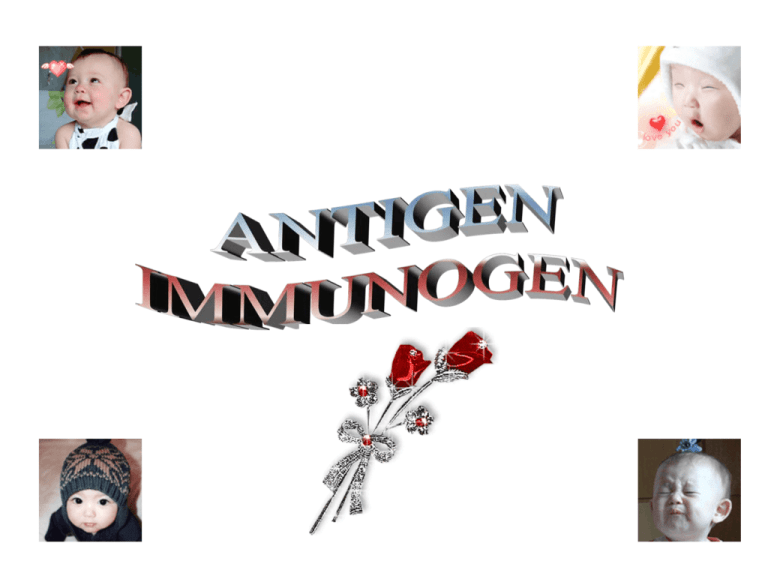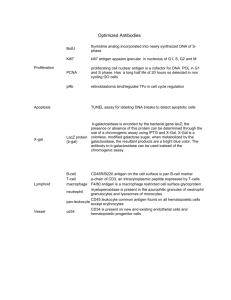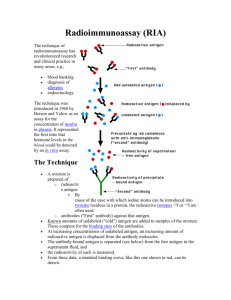Antigen - Immunogen
advertisement

I. Definition of antigen Antigen is substance which when introduced parentally into the body stimulates the production of an antibody with which it reacts specifically and in an observable manner Antigen: Immmunogen Tolerogen Allergen Vaccine 1. Immunogen: the antigen that induce specific immune response Microbes; bacteria ,virus; fungi and parasites xenoantigenei or allogeneic tissues or organs: grafted skin , bone marrow 2.Tolerogen: antigen that induce Immunologic tolerance • Immunologic tolerance is unresponsiveness to an antigen that is induced by prior exposure to that antigen. tolerogen 3. Allergen: antigen that induce Anaphylaxis (severe immediate hypersensitivity reaction occurring as a result of rapid generalized mastcell granulation) Allergen: some medicine, flower powder, seafood 4. Vaccine: antigens that induce a protection immune response against microbes and are used to prevent diseases Killed vaccine: Rubella virus Attenuated vaccine: Measles Toxoid :Tetanus Based on Immunogenicity Complete antigen : substances with both immunogenecity and immunoreactivity By convention , we call complete antigen as antigen. Incomplete antigen (hapten): substances only with immunoreactivity Hapten +carrier complete antigen (immunogens) Hapten: Only possess immunoreactivity Carrier: Make hapten obtain the immunogenicity 2. Two properties of immunogen 1. Immunogenicity An ability of antigen which can stimulate the body to evoke a specific immune response. 2. Immunoreactivity An ability of antigen which can combine with corresponding Ab or sensitized lymphocyte Based on Chemical nature • Proteins Majority of immunogens are proteins (pure proteins or they may be glycoproteins or lipoproteins). Proteins are usually very good immunogens. • Polysaccharides Pure polysaccharides and lipopolysaccharides are good immunogens. • Nucleic Acids Nucleic acids are usually poorly immunogenic. However, they may become immunogenic when single stranded or when complexed with proteins. • Lipids In general lipids are non-immunogenic, although they may be haptens. According to source of antigens • Xenoantigen • Alloantigen • Autoantigen • Heterophile antigen (1) Xenoantigen • An antigen that is found in more than one species. An antigen is something that is capable of inducing an immune response. • The prefix "xeno-" means foreign or other. It comes from the Greek "xenos" meaning stranger, guest, or host. • Pathogens: bacteria, virus , fungi, parasite • Exotoxin and toxoid Exotoxin Produced by G+ bacteria Strong antigenicity and pathogenicity Toxoid : exotoxin that loses its toxicity but maintains its antigenicity under suitable conditions (low concentration of formaldehyde ) Such as tetanus toxoid , diphtheria toxoid bacteria Pathogens Fungi HIV Heterophile Ag (forssman Ag) Common Ags shared by different species ( between human and animal or microbes, between different species of microbe) (eg) M protein of streptococus bears common antigen determinant with basement membrane of kidney (This common between bacteria and human being can causes poststreptococcal glomerulonephritis) No specificity of species Significance . immunopathology . Diagnosis (2) Alloantigen Antigens of red blood cell • ABO system (blood typing) - very important in transfusion • Rh system (Han race :>99%Rh+)----haemolytic disease of the newborn (HDNB) HLA system (Human leukocyte antigen) - relate to transplantation - very important in immune regulation ABO system Blood typing A B AB O antigen of RBC A B A,B - antibody in serum anti-B anti-A anti-A, anti-B (3) Autoantigen Release of sequestered Ag Lens protein is released into blood to induce immune response to induce inflammation of lens Change of molecular structure of auto-tissues Denatured IgG becomes antigen to induce production of antibody ( rheumotoid factor) In patient suffering from rheumotoid arthritis II. According to whether need the help of T cells when B cells produce Ab TD-Ag (thymus dependent Ag ) TI-Ag (thymus independent Ag) 1.TD-Ag (thymus dependent Ag ) TD-Ag can stimulate B cell to produce Ab with the help of T cell The most of TD-Ag belong to protein many kinds of determinants stimulate B cell to produce :IgG, IgM, IgA capable of inducing CMI immune memory 2. TI-Ag (thymus independent Ag) TI-Ag can stimulate B cells to produce Ab without the help of T cell most are polysaccharide more ,same, repeat determinant only induce B cell to produce IgM can not induce CMI no immune memory SUPERANTIGENS • When the immune system encounters a conventional T-dependent antigen, only a small fraction (1 in 104 -105) of the T cell population is able to recognize the antigen and become activated (monoclonal/oligoclonal response). • However, there are some antigens which polyclonally activate a large fraction of the T cells (up to 25%). These antigens are called superantigens Eg: Staphylococcal enterotoxins (food poisoning), Staphylococcal toxic shock toxin (toxic shock syndrome), Staphylococcal exfoliating toxins (scalded skin syndrome) and Streptococcal pyrogenic exotoxins (shock). The diseases associated with exposure to superantigens are, in part, due to hyper activation of the immune system and subsequent release of biologically active cytokines by activated T cells. • Tumor specific Ag ( TSA) Only expressed on the tumor cells but normal cells The tumor antigens encoded by genomes oncogenic virus EB virus ---B cell lymphoma HPV-cervical carcinoma • Tumor associated Ag (TAA) Highly expressed on tumor cells but lowly normal cells, such as AFP CEA expressed on AFP (alpha-fetoprotein): over-expression in liver cancer CEA (carcinoembryonic antigen): over-expression in carcinoma of colon , pancreas, stomach ,and breast DEPEND ON SIZE • Very high molecule haemocyanin (MW 6.75million) –highly antigenic • Low molecular weight molecule (<10,000) non antigenic or feeble They render antigenicity by absorbing inert particles like bentonite or kaolin 1. Antigen must be foreignness to immune system: . What substances are foreignness to immune system ? According to Burnnet’s clone selection theory , foreignness ( non-self) means substances that never contact with lymphocytes during embryo period. What kinds of substances can be foreignness to immune system? (1) Heterogeneous substances Various pathogens, xenoantigeneic tissues (2) Allogeneic substance grafted allogeneic tissues or organs (3)Autoantigenic components that never contact with lymphocytes during embryo period Release of sequestered antigen-----Such as lens protein, sperm etc. Change of molecular structure of auto-tissue For example, denatured IgG in patient suffering from rheumatoid arthritis becomes antigen to induce production of antibody ( rheumatoid factor) III. Specificity and cross reaction of antigen • Specificity is a cardinal feature of the adaptive immune system • Specificity is referred to that immune responses are directed toward and able to distinguish between distinct antigen or small parts of macromolecular antigens. • This fine specificity is attributed to lymphocyte antigen receptors that may bind to one molecule but not to another with only minor structural differences from the first Specificity of Ag Ab1 Ab2 Ab3 • Specificity exists in both immunogenecity and immunoreactivity • Specificity is the basis of immunologic diagnosis and immunologic therapy as well as basic feature of adaptive immunity Degradability • Antigens that are easily phagocytosed are generally more immunogenic. This is because for most antigens (T-dependant antigens) the development of an immune response requires that the antigen be phagocytosed, processed and presented to helper T cells by an antigen presenting cell (APC). 1. Antigen determinants (epitope) (1) The portion of antigen molecules which can be specifically recognized by antibody or antigenic receptor of lymphocytes. • Protein antigen----5-15 amino acid residues • Polysaccharide antigen----5-7 polysaccharide residues Properties of Epitopes • They occur on the surface of the protein and are more flexible than the rest of the protein. • They have high degree of exposure to the solvent. • The amino acids making the epitope are usually charged and hydrophilic. Methods to identify epitopes 1. Immunochemical methods • • • 2. 3. ELISA : Enzyme linked immunosorbent assay Immunoflurorescence Radioimmunoassay X-ray crystallography: Ag-Ab complex is crystallized and the structure is scanned for contact residues between Ag and Ab. The contact residues on the Ag are considered as the epitope. Prediction methods: Based on the X-ray crystal data available for Ag-Ab complexes, the propensity of an amino acid to lie in an epitope is calculated. • In protein antigens epitopes can be defined in terms of: – Amino acid composition – Protein location – Length (5-15 amino acids) • Immunodominant epitopes: – Epitopes bound by a greater proportion of antibodies than others in a normal in vivo immune response. – Also known as Major Antigenic Sites. • Epitopes can be divided into 2 classes: – Discontinuous epitopes – Continuous (linear) epitopes (2) A change of antigenic determinant (characteristics, number and conformation) can influence the specificity of Ag. Antigen determinant is the sites of Ag combining with Ab The chemical component , arrangement and conformation affect the specificity of antigen Antigen-antibody complexes are held together by noncovalent forces (therefore, antigen binding by antibody is reversible) 2. Antigenic valence Total number of determinants which can be bound by antibody or antigenic receptor of lymphocytes is called antigenic valence. Most natural antigens are polyvalence antigen. 3. Classification of antigenic determinant (1)According to the structure of Ag determinants • Conformational determinants • Sequential (or linear) determinants Conformational determinants Conformational determinants are formed by amino acid residues that aren’t in a sequence but become spatially juxtaposed in the folded protein. Sequential (or linear) determinants Epitopes formed by several adjacent amino acid residues are called linear determinants. (2)According to types of cells recognizing antigenic determinants • T cell determinants (T cell epitopes) • B cell determinants (B cell epitopes) Difference between T cell epitope and B cell epitope T cell epitope Receptor TCR Nature short peptide Size 8-17 amino acid residues B cell epitope BCR proteins, polysaccharides 5-15 amino acid residues or 5-7 monosaccharides Types linear epitope conformational epitope or linear epitope Position any position in antigen mostly exist on the surface of antigen Antibodies, unlike TCRs, bind continuous (linear) or conformational epitopes • Usually antigens recognized by antibodies are in their native configuration. Antibodies bind on the surface of the antigen (e.g., amino acids that are buried in the center of a globular protein are not accessible by antibodies).. Antibodies bind linear and conformational epitopes. • Antibodies can bind proteins, carbohydrates, lipids and nucleic acids (essentially any macromolecule). (most antibodies bind proteins or carbohydrates) Unlike antibodies, the TCR binds only continuous (linear) epitopes • The TCR binds peptides from processed protein (proteins that have been chopped-up). Accordingly, TCRs can bind peptides that are derived from the surface of a proteins or peptides from the interior of the protein. • Because of processing and presentation of peptides, the TCR binds only linear epitopes. TCRs can bind non-surface epitopes buried in the center of a big protein and can bind peptides from proteins from inside of bacteria and viruses. TCRs bind only peptides [not nucleic acids, not lipids and not carbohydrates (rare exceptions)] because MHC presents only peptides (not nucleic acids, not lipids, not carbohydrates). Immunological Synapse APC T cell ICAM-1,2 LFA-1 adhesion LFA-3 CD2 CD4 or CD8 TCR signaling antigen/MHC TCR CD28 B7-1,2 Co-stimulation CD40L LFA-1 TCR Immature immunological synapse CD40 TCR LFA-1 Mature immunological synapse TCR down-regulation Co-stimulation of T cell activation Induced by inflammation (TLR activation, TNF-α, IL-1) B7-1 (CD80) CD28 Constitutive expression B7-2 (CD86) APC T cell WT(+LPS) WT(-LPS) CD28-/- Defective IL-2 production in the absence of CD28 (+ or - LPS) CD28 is required for T cell activation CD28 stimulates a subset of TCR signaling pathways. CD40L-CD40 interaction stimulates B7 expression. Antigen/MHC CD40 is expressed on APCs (DC, B and Mφ) B7 TCR Activation of T cell T CD28 CD40 Antigen/MHC B7 CD40 Antigen/MHC Further induction of B7 Stronger co-stimulation B7 CD40 TCR Induction of CD40L T CD28 CD40L interacts with CD40. CD40L TCR CD28 CD40L T CD40 or CD40L deficiency reduces T cell activation. CTLA-4 down-regulates co-stimulation. CD28 B7 T cell CD28 is expressed on resting T cells. activation APC B7 CD28 T cell CTLA-4 is induced after T cell activation. CTLA-4 is homologous to CD28. APC CTLA-4 deficiency leads to Lymphoproliferation disorder The mice die 3-4 weeks after birth. The mice suffer massive tissue destruction. activation Hyper-proliferation of T cells CTLA-4 B7 APC T cell CTLA-4 binds B7 tighter than CD28. CTLA-4 may also send a negative inhibition signal through intracellular domain. 3.Common antigen and cross reaction (1) Common antigen ( common determinants in fact ) Different bacteria which possess the same epitopes are called common antigen. (2) Cross reaction ---Existence of common determinants Because there are some common antigen determinants existing in different microbes, so the antiserum against one kind of microbe can also react with another microbe,this called cross reaction. flagellum Typhoid bacillus Paratyphoid bacillus 2 1 H Ag 2 A 3 B O Ag Anti-typhoid serum Anti-Ag2 Anti-Ag2 Anti-Ag1 AntiParatyphoid serum Anti-Ag3 (3) Significance In clinic, existence of cross reaction may lead to wrong diagnosis. Flu virus typhoid What you should know by the end of this lecture Definition and characteristics of antigen Definition of antigenic determinants,conformational determinants and linear determinants Difference between T cell epitopes and B cell epitopes Definition of common antigen and cross reaction Difference between TD-Ag and TI-Ag Immunological synapse.








